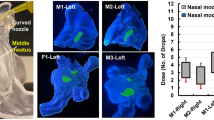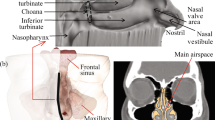Abstract
The objective of this study was to determine the influence of individual anatomical differences on intranasal drug deposition. The data of a comparison of seven different administration techniques in ten healthy volunteers was used in this single-blind crossover pilot study. After intranasal administration of a dyed test formulation, endoscopic video imaging was done on seven non-sequential days. The deposition pattern per individual around the head of the middle turbinate was analyzed for each technique and correlated with the individual anatomy. Decreased deposition of dyed test formulation in the target area around the head of the middle turbinate was observed in the presence of minor septal deviations, narrow nasal valve areas, or inferior turbinate hypertrophy; a lateral head position helps to bypass a minor septal deviation. Although results are preliminary, we conclude that anatomy and head position are important factors in the deposition of topical nasal drugs and may be the key to improving individual local nasal (steroid) treatment.



Similar content being viewed by others
References
Aggarwal R, Cardozo A, Homer JJ (2004) The assessment of topical nasal drug distribution. Clin Otolaryngol 29:201–205
Aukema AA, Mulder PG, Fokkens WJ (2005) Treatment of nasal polyposis and chronic rhinosinusitis with fluticasone propionate nasal drops reduces need for sinus surgery. J Allergy Clin Immunol 115(5):1017–1023
Benninger MS, Hadley JA, Osguthorpe JD, Marple BF, Leopold DA, Derebery MJ, Hannley M (2004) Techniques of intranasal steroid use. Otolaryngol Head Neck Surg 130:5–24
Chalton R, Mackay I, Wilson R, Cole P (1985) Double-blind, placebo-controlled trial of betamethasone nasal drops for nasal polyposis. Br Med J 291:788
Dowley AC, Homer JJ (2001) The effect of inferior turbinate hypertrophy on nasal spray distribution to the middle meatus. Clin Otolaryngol 26:488–490
Fokkens WJ, Lund V, Bachert C, Clement P, Helllings P, Holmstrom M, Jones N, Kalogjera L, Kennedy D, Kowalski M, Malmberg H, Mullol J, Passali D, Stammberger H, Stierna P (2005) EAACI position paper on rhinosinusitis and nasal polyps executive summary. Allergy 60(5):583–601
Hardy JG, Lee SW, Wilson CG (1985) Intranasal drug delivery by sprays and drops. J Pharm Pharmacol 37:294–297
Homer JJ, Maughan J, Burniston M (2002) A quantitative analysis of the intranasal delivery of topical nasal drugs to the middle meatus: spray versus drop administration. J Laryngol Otol 116:10–13
Homer JJ, Raine CH (1998) An endoscopic photographic comparison of nasal drug delivery by aqueous spray. Clin Otolaryngol 23:560–563
Karagama YG, Lancaster JL, Karkanevatos A, O’Sullivan G (2001) Delivery of nasal drops to the middle meatus: which is the best head position? Rhinology 39:226–229
Kayarkar R, Clifton NJ, Woolford TJ (2002) An evaluation of the best head position for instillation of steroid nose drops. Clin Otolaryngol 27:18–21
Lund VJ, Flood J, Sykes AP, Richards DH (1998) Effect of fluticasone in severe polyposis. Arch Otolaryngol Head Neck Surg 124:513–518
Mackay I (1997) Infective rhinitis and sinusitis. In: Scott Browne, Otolaryngology 6th edn. Butterworth Heinemann, Oxford, p 4/8/24
Merkus P, Ebbens FA, Muller B, Fokkens WJ (2006) The “best method” of topical nasal drug delivery: a comparison of seven techniques. Rhinology 44:102–110
Morén F, Bjornek K, Klint T, Wagner ZG (1988) A comparative distribution study of two procedures for administration of nose drops. Acta Otolaryngol 106:286–290
Mygind N (1979) Conventional medical treatment. In: Nasal allergy, 2nd edn. Blackwell Scientific Publications, Oxford, pp257–270
Parkinson SN (1933) A lateral head-low position for nasal and sinus treatment. Arch Otolaryngol 17:787–788
Parkinson SN (1939) Non-traumatic ventilation treatment of the nose and sinuses. J Laryngol Otol 54:611–620
Proetz AW (1926) Displacement irrigation of nasal sinuses. Arch Otolaryngol 4:1–13
Proetz AW (1927) Further data on the displacement method in sinuses. Ann Otol Rhinol Laryngol 36:297–323
Raghavan U, Logan BM (2000) New method for the effective instillation of nasal drops. J Laryngol Otol 114:456–459
Stammberger H (1986) Endoscopic endonasal surgery: concepts in treatment of recurring rhinosinusitis. Part I. Anatomic and pathophysiologic considerations. Otolaryngol Head Neck Surg 94:143–147
Tabor MP, Braakhuis BJ, van der Wal JE, van Diest PJ, Leemans CR, Brakenhoff RH, Kummer JA (2003) Comparative molecular and histological grading of epithelial dysplasia of the oral cavity and the oropharynx. J Pathol 199(3):354–360
Tsikoudas A, Homer JJ (2001) The delivery of topical nasal sprays and drops to the middle meatus: a semiquantitative analysis. Clin Otolaryngol 26:294–297
Weber R, Keerl R (1996) Einsatz moderner Bilddatenverarbeitung in der klinisch-rhinologischen Forschung. Eur Arch Otorhinolaryngol Suppl 1:271–296
Weber R, Keerl R, Radziwill R, Schick B, Jaspersen D, Dshambazov, Mlynski G, Draf W (1999) Videoendoscopic analysis of nasal steroid distribution. Rhinology 37:69–73
Acknowledgment
We wish to thank Valois (France) for their support with the single-unit dose device.
Author information
Authors and Affiliations
Corresponding author
Rights and permissions
About this article
Cite this article
Merkus, P., Ebbens, F.A., Muller, B. et al. Influence of anatomy and head position on intranasal drug deposition. Eur Arch Otorhinolaryngol 263, 827–832 (2006). https://doi.org/10.1007/s00405-006-0071-5
Received:
Accepted:
Published:
Issue Date:
DOI: https://doi.org/10.1007/s00405-006-0071-5




